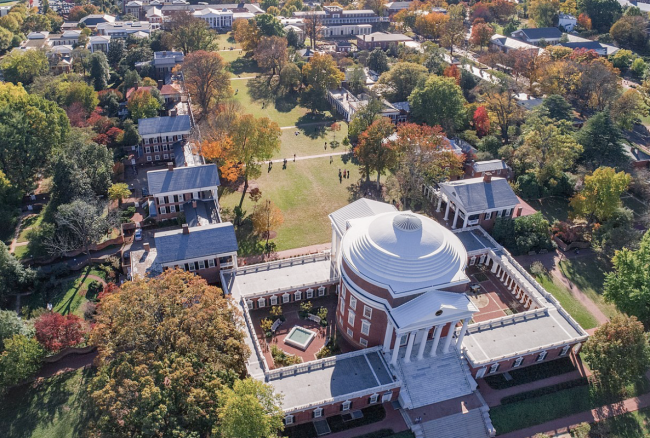You have /5 articles left.
Sign up for a free account or log in.

The University of Virginia’s Board of Visitors and its Faculty Senate are clashing over how the Senate selects its representative to the board.
Wikimedia Commons
The University of Virginia’s Board of Visitors increased faculty say in its affairs following its bungled 2012 attempt at firing then president Teresa Sullivan. In 2015, the still-penitent board even added a nonvoting faculty representative to its ranks. Now the board is signaling that it may cut that seat if it can’t help pick whom the faculty rep is.
“The fact of the matter is, in the Commonwealth of Virginia, there’s no requirement that there be any faculty representative,” Whittington W. Clement, board rector, told Inside Higher Ed. “Even though it’s not required, we have felt it’s appropriate to have a faculty representative serve. So, when you extend a hand to an organization to participate, and the organization then tries to stipulate how they’re going to participate, that doesn’t send a good message to those inviting the participation.”
What does the board want, exactly? A change to UVA’s Faculty Senate bylaws, such that instead of being sent a single, faculty-elected representative, the board could pick from a slate of three or four faculty-backed candidates.
The Senate is set to vote on a motion to this effect following its meeting next week. Specifically, the proposed change would make it so that the immediate past Senate chair would be nominated to that slate, along with two additional, Senate-elected candidates who may or may not be faculty senators. This follows an August missive from Clement to senators saying, “Your cooperation will ensure that this position continues to be filled with one of several faculty senators, each of whom the Faculty Senate entrusts with this responsibility.”
Faculty Divided
The faculty over all is divided on the proposal. Some argue it’s more important to retain a faculty board seat than to insist on a particular selection process. Others say that at Thomas Jefferson’s university, faculty members alone should choose who represents them to the board—especially one that’s overreached in the not-so-distant past.
“Faculty have a legitimate desire to ensure that their representative is truly representative of the faculty as evidenced by majority support,” UVA’s chapter of the American Association of University Professors recently wrote to the Senate and the board. “Selecting the individual from a slate of candidates could result in the seating of an ostensible ‘faculty representative’ on the board who has slight electoral support and does not reflect the aspirations and perspectives of the faculty at large.”
Aaron Bloomfield, a professor of computer science and faculty senator who introduced the proposed bylaw change, said that the amendment “is an effort to work cooperatively with the Board of Visitors, rather than work combatively against them. They have requested we make this change for some time, and I am concerned we will lose our representative to the board if we do not.”
Bloomfield said he thought that “most senators are either still deciding or in favor of the amendment,” while “a small but vocal minority is against it.”
Tish Jennings, Senate chair and professor of curriculum, instruction and special education, estimated that support for the amendment was “about 50-50, so I really don’t know what the outcome’s going to be. I’m trying to navigate this the best I can in a way that doesn’t favor one side or the other, because I understand all the concerns, 100 percent.”
Whatever happens, Jennings said, preserving faculty representation on the board “is really critical. Both the faculty and the Board of Visitors get to know one another and understand their positions and needs and concerns.”
Professors on both sides of the debate have pointed to the greater political climate in Virginia as a reason for their respective positions. That is, all voting visitors are political appointees who serve up to two four-year terms. And Republican governor Glenn Youngkin, who rode to victory last year campaigning against classroom discussions of so-called divisive concepts like race and gender, has already made several controversial moves regarding higher education. These include telling state college presidents to hire faculty and staff with “diverse political perspectives,” certain trustee appointments (one at UVA), and pressuring the Virginia Community College System’s governing board to add one of Youngkin’s representatives to its search committee for a new chancellor.
Even before Youngkin, UVA’s board had asked multiple times for a slate of possible faculty reps. The Senate continued to choose one rep, however—nearly always the Senate’s immediate past chair. In 2020, in a 52-to-4 vote, the Senate passed a bylaw formalizing the practice of electing one rep. But the board’s new insistence—and the not-so-veiled threat of losing faculty representation altogether—portends the end of a certain period of board contrition.
Alternatives and Perspectives
Asked why the board wants to choose a faculty rep, Clement said that it’s mostly to align how the board chooses its student representative—from a slate of student-backed candidates—with how it chooses its faculty rep. He again cited the Virginia statute that requires governing boards to have a student representative, but not a faculty one. (Elsewhere Clement has said that the board should be able to choose “who is the best fit for current board issues.”)
That statute says, in part, that boards of visitors of “shall” appoint one or more students as nonvoting, advisory representatives, and “may" appoint one or more nonvoting, advisory faculty representatives.
In the case of local boards, that statute also says faculty representatives “shall be chosen from individuals elected by the faculty or the institution’s faculty senate or its equivalent.” UVA’s board says it interprets this to mean that the Senate should recommend a slate of candidates, rather than single person.
According to analysis by UVA’s AAUP chapter, seven of 10 other public universities in Virginia send a single elected faculty rep to their respective governing boards (in most cases this is the head or immediate past head of the institution’s Faculty Senate). In two of the 10 cases, the board picks from two faculty-backed candidates. In the final case, the board confers with the president to choose a faculty rep.
Given that the state statute leaves room for interpretation, UVA’s AAUP chapter has proposed both to the Senate and the board that visitors “notify the senate of issues anticipated for the coming term so that senators are able to consider the relevant qualifications of candidates as part of the nomination and election process.” The AAUP also has proposed that the board decline to seat anyone unsatisfactory, rather than risk a “contentious and potentially unsuccessful bylaw amendment process.”
Walter Heinecke, UVA’s AAUP chapter president and associate professor of educational research, evaluation and statistics, said that “from our perspective, respect for faculty shared governance means following a process or adopting a bylaw that reflects an informed, deliberative decision by the entire faculty or the Faculty Senate.” Such a process was followed in 2020 when the Senate voted decisively to send one elected rep to the board, he said, and “now the board wants to overturn that,” via “a rushed process, and even though the rector has not come to explain his rationale.”
Without any clear explanation by Clement, Heinecke said, the situation recalls what the national AAUP said in its 2013 report on the Sullivan debacle: “The investigating committee met with person after person, vainly striving for some explanation for the board’s action and the process it had followed that would give direction to what otherwise appears to be nothing more than a crude exercise of naked power.”
Even with more time for debate and study, Heinecke continued, “This proposed bylaw amendment as is would be a mistake. It dilutes the faculty representative from someone who represents the first choice of the faculty to someone who represents the first choice of the board.”
Barbara Gitenstein, senior vice president for consulting at the Association of Governing Boards of Universities and Colleges and president emerita of the College of New Jersey, said that AGB’s most recent data indicate that 18 percent of public institutions’ governing boards have voting faculty reps and 9 percent have nonvoting faculty reps. (For private institutions, these figures were 18 percent and 15 percent respectively; the remaining share of institutions, both public and private, presumably have no faculty board representation.)
Faculty representatives arrive at boards by different means, Gitenstein said, and some boards expect to choose among a slate of candidates. This method can be “a very good way to go,” she added, as the board can “choose someone that fits a slot that they need—an area of expertise, a perspective that’s missing on the board, so that they have a diversity of opinion in dealing with complex issues.”
AGB didn’t have recent data on how faculty members are elected or nominated to boards, but a 2012 survey from Cornell University’s Higher Education Research Institute found that 60 percent of faculty reps on governing boards were elected by faculty members. Another 17 percent were ex officio trustees, often by linked to their role in a faculty governing body, and 13 percent were nominated by the faculty but subject to approval by the board. The remaining 10 percent were appointed in other ways.

 (1).jpg?itok=6bFBLhpi)







.jpg?itok=sZ1Pn-fP)